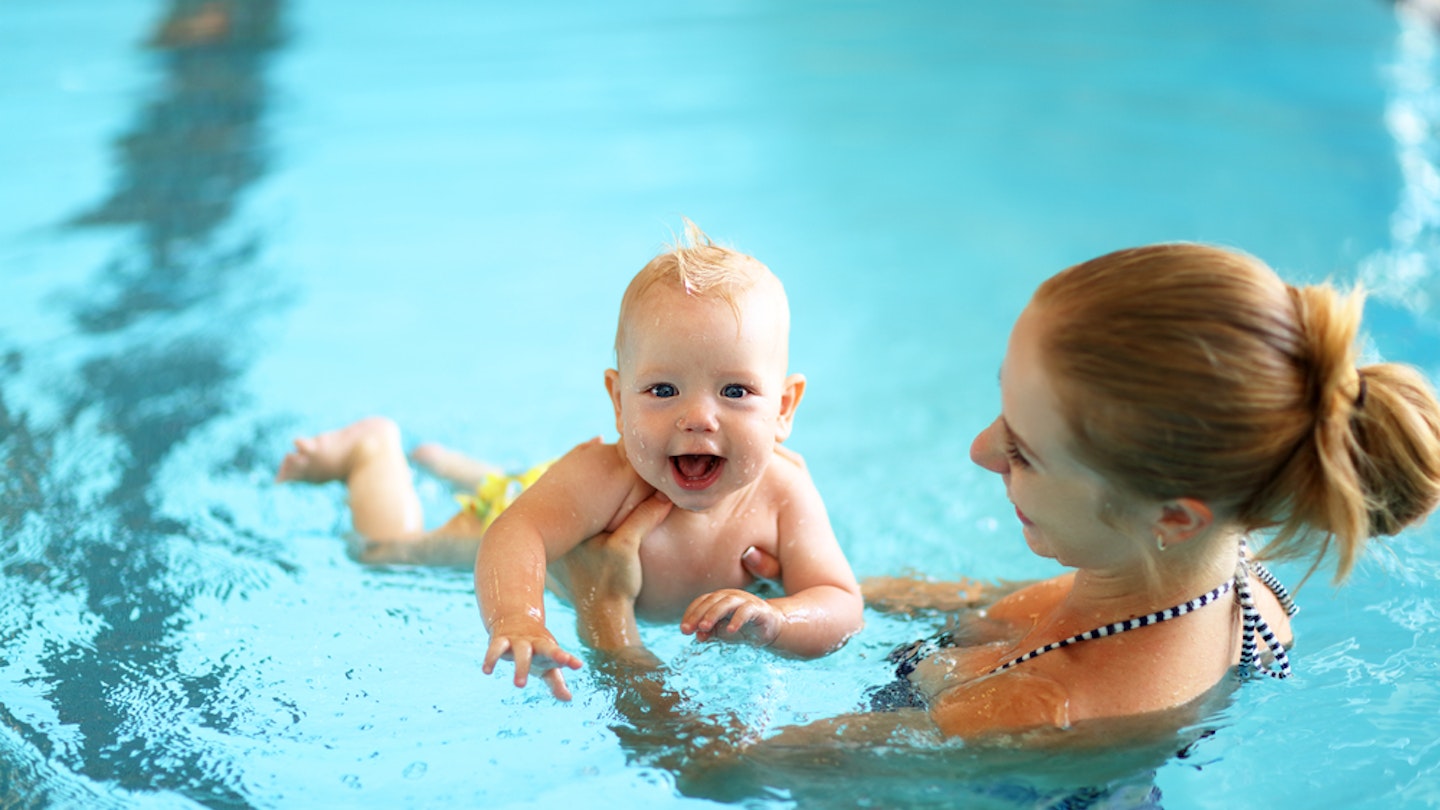With babies spending nine months suspended in fluid, it’s no surprise that they love the sensation of being in the water and you're probably wondering when you can take your baby swimming for the first time (with or without swimming aids). Whether you're already thinking about baby swimming lessons or are keen to know when your baby can actually go swimming, as well what baby should wear when swimming, then this guide will make sure you’re fully prepared for the experience.
We've also got all the expert tips and advice from Olympic swimmer Rebecca Adlington, who has shared her top tips for taking your baby swimming, as well as her advice for helping your little one love the water, with the help of her experience from when her daughter Summer was a baby.
When can babies go swimming?
According to the NHS, 'You can take your baby swimming at any age, both before and after they have been vaccinated. It does not matter if they have not yet completed their course of vaccinations.' So really, the choice is completely yours. While you might not feel comfortable taking them to a big indoor water park just yet, many pools and leisure centres offer quiet and calm baby swim sessions.
"I first took Summer swimming when she was three and a half weeks old. It sounds really early, but it’s fine for your baby to go in the pool at that age. Lots of people were shocked when I said I’d taken her swimming before she’d had all her baby vaccinations, but the NHS guidelines say that you don’t have to wait until your baby’s had them," explains Rebecca.
"Most baby swimming classes won’t take you if your baby hasn’t had her jabs, but to be honest you don’t need to go to a class the first few times, as you’re only in the pool for about 10 minutes."
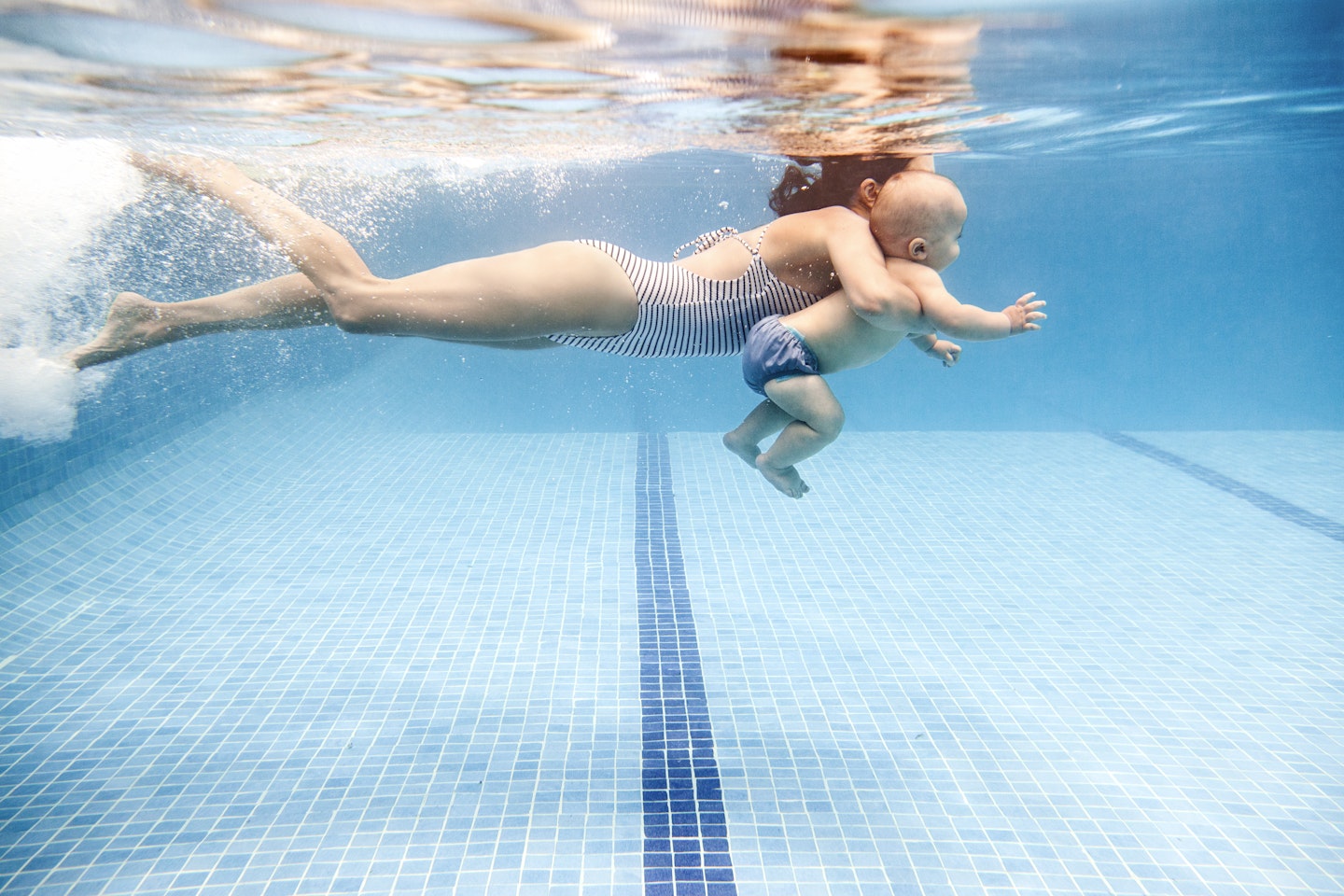
If you’re recovering from a c-section or a difficult birth, it’s best to wait until after you’ve had your six-week check before going in yourself, but encourage your partner to take your baby.
M&B expert Alison Duff, director of Calma Baby, a swimming facility for pregnancy to preschool in Cambridgeshire, (calmababy.com), says: "Although babies can go swimming at any age because public pools are busy and noisy, you may want to start the process of preparing your newborn baby for swimming at home. A relaxing bath with him the day after birth can be a wonderful welcome to the world."
Getting your baby used to the water at home
• Fill the bath 20cm to 30cm deep with warm water at 32°C to 33°C, and ensure the bathroom is warm (above 24°C). Get in the tub and have someone pass you your baby. Spend some time cuddling him on your chest and enjoying the skin-on-skin contact.
• Then try laying your baby on their back. Cradle them initially, keeping them close to you and bringing their hands to the midline of their chest. If they're happy, gradually lessen the amount of support and offer them the freedom to float with you, placing one hand under their head, and the other under their bottom. Let his ears submerge and use just enough support to stop their head sinking underwater. Take a breath, relax your arms and shoulders and let them float.
• Trust your instincts about how your baby responds to the experience and adjust the position or amount of support you’re giving them as necessary. Ten minutes of fun in the bath is plenty for the first session. You may want to use a baby swimming ring once they get more comfortable in the pool.
Typical responses to newborn floating can be intense eye contact, kicking, wriggling, smiling, crying and even complete stillness. But don’t worry if your first session isn’t a wonderful experience. If your baby cries then get out, wrap him in a warm towel and try again another time.
Benefits of baby swimming
If your baby enjoys their time in the water then that’s great, as Swim England share plenty of benefits to them having a splash about:
• It strengthens their little muscles
• It improves their balance, coordination and their motor skills
• A great time for you and your baby to bond
• Improves their sleeping pattern
• Improves their appetite (all that splashing about is hard work)
• Builds water confidence
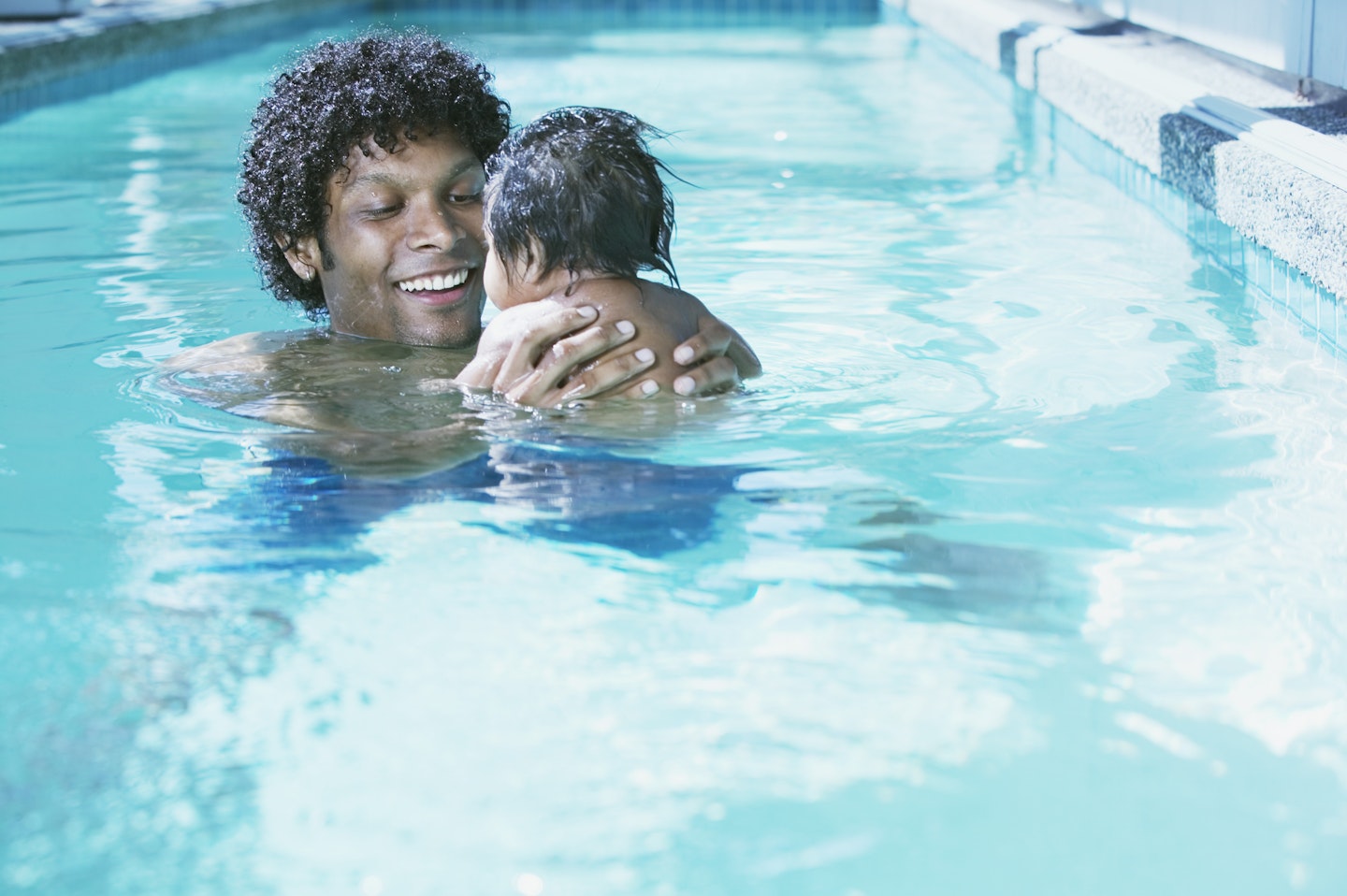
Baby swimming lessons
If you would like some in-person support when taking your baby swimming, why not see if your pool offers swimming lessons or classes? It's a lovely chance to meet other parents and for your youngster to see other babies in the same situation as her.
Make sure the lessons you pick are run by an instructor with a national recognised qualification and who has been trained specifically to teach babies and toddlers. This is not only important for your baby's safety, but to also make sure they have a positive pool experience.
There are also plenty of swimming programmes available especially for babies all around the country. Here are a few you might want to look into:
• Aquatots
If you’re confident enough to visit a public pool check the temperature is no less than 32°C and choose a quiet time. If your baby is unsettled, keep them close, use a rhythmic bobbing motion and ensure their ears are submerged when back floating to help filter out any noise.
If your baby was born prematurely, then be sure to consult your health professional before visiting a public pool.
What do I need to take my baby swimming?
• A swimming costume
• A snack if your baby is weaning (swimming is hungry work)
• A bottle of milk if you're bottle-feeding
• A changing mat and your changing bag
Things to think about beforehand
• Find out what’s at your local pool. "I’d been to ours loads, so I knew it was warm enough and had baby-changing facilities," says Rebecca. "If you haven’t been before, ring first or pop down and have a look. It makes it less daunting when you take your baby for the first time. Also, ask what the temperature of the water is. It needs to be at least 32˚C for young babies under three months."
• Don't be put off if you don’t have anyone to go with. "I often took Summer on my own and it’s absolutely fine!" says Rebecca.
• It's also worth asking for a swimming timetable. There’ll be all sorts of stuff going on, including toddler sessions, inflatable sessions and even music sessions. Different experiences will mean your baby will do different things. Perhaps they'll need to hold their breath or blow bubbles, and they'll be so involved they won’t even realise they're learning.
Baby swimming tips from Rebecca Adlington
1. Getting your baby into the pool
Most baby pools have big steps that go straight into the water, so it’s easy to carry your baby into the pool. When you go down the steps, hold your baby in a sitting position with their chest against yours, and support their bum with one hand and, if they're really little, hold their head and neck with the other. Just treat it the same as carrying your baby downstairs at home.
2. How to hold your baby in the pool
If your baby's facing outwards they're going to think, ‘Where are you taking me?’ If they can make eye contact with you, they'll know everything’s fine because they can see you’re relaxed. Keep smiling and say, ‘Where are we?’, so they know it’s OK. If the pool doesn’t have wide steps then, depending on how confident you are in the water and the age of your baby, gently lay them on the side of the pool (make sure you have a towel with you to put down first), then slip in the water and quickly pick them up again. If you don’t feel confident, or the pool only has steep steps, ask the pool attendant for help.
To start with, keep your baby on their back, as it’s how they are in the bath, so the pool will feel like a similar environment. Make sure your baby’s head is supported by your arm, and cradle their back and bum with your hands. It’s important that they feel safe in the water, so cradle their body close to you, so they can see you. Chat to your baby all the time to reassure them.
Encourage your baby to experience buoyancy
"Stand behind your baby, so their head is resting on your chest. Put your hands under their back, so the rest of their body is floating. They'll soon begin to move their arms and legs about and enjoy the feeling," reassures Rebecca. "Let them float on their back at first, so they can see you. Summer preferred being on her front when she was crawling. To support her, I put a hand under her tummy and one under her chin, so her face didn't go in the water."
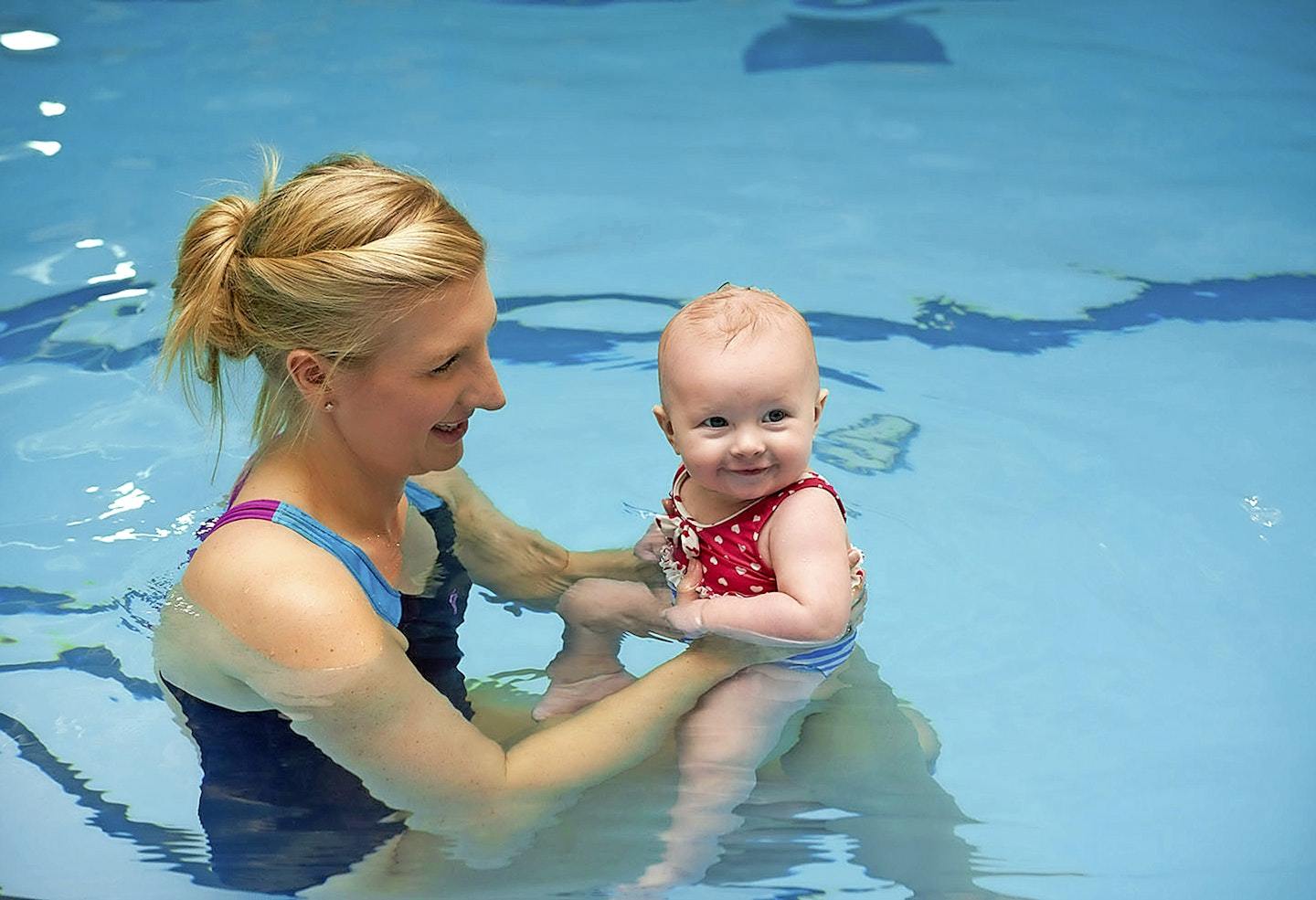
3. Getting your baby used to the water
Building water confidence before your baby hits the pool will make the transition easier.
Let your baby get used to the feeling of water on their face when they're in the bath by gently trickling it over their head. "Summer had a toy that rains water and we took it in the bath every single night to trickle water over her head and face," says Rebecca.
To try it when you’re in the pool, sit on the steps and put your baby on your knee and hold them around their waist so they're facing towards you. Let water trickle off your fingertips onto their head. Even wetting your hand and rubbing it against their cheek will get them used to the sensation. "When Summer was older, I would dip her and quickly lift her back up, so she felt confident having her whole head underwater," says Rebecca.
Once your baby is comfortable floating, try putting their ears under the water. The best way to do this is to hold them lengthways across your body with one hand under their head and one supporting their bum. Slowly lower their head so their ears are underwater. It’s a new sensation for babies, as the water muffles their hearing.
"We practised by putting Summer’s ears underwater in the bath. She wasn’t sure at first, so don’t worry if your baby is a bit squirmy: they're just trying to suss out what’s going on. Try it for a couple of seconds to get them used to the feeling," reassures Rebecca. "It’s a really good way to prepare them for putting their head fully under the water. Just keep reassuring them with lots of eye contact and encouraging smiles."
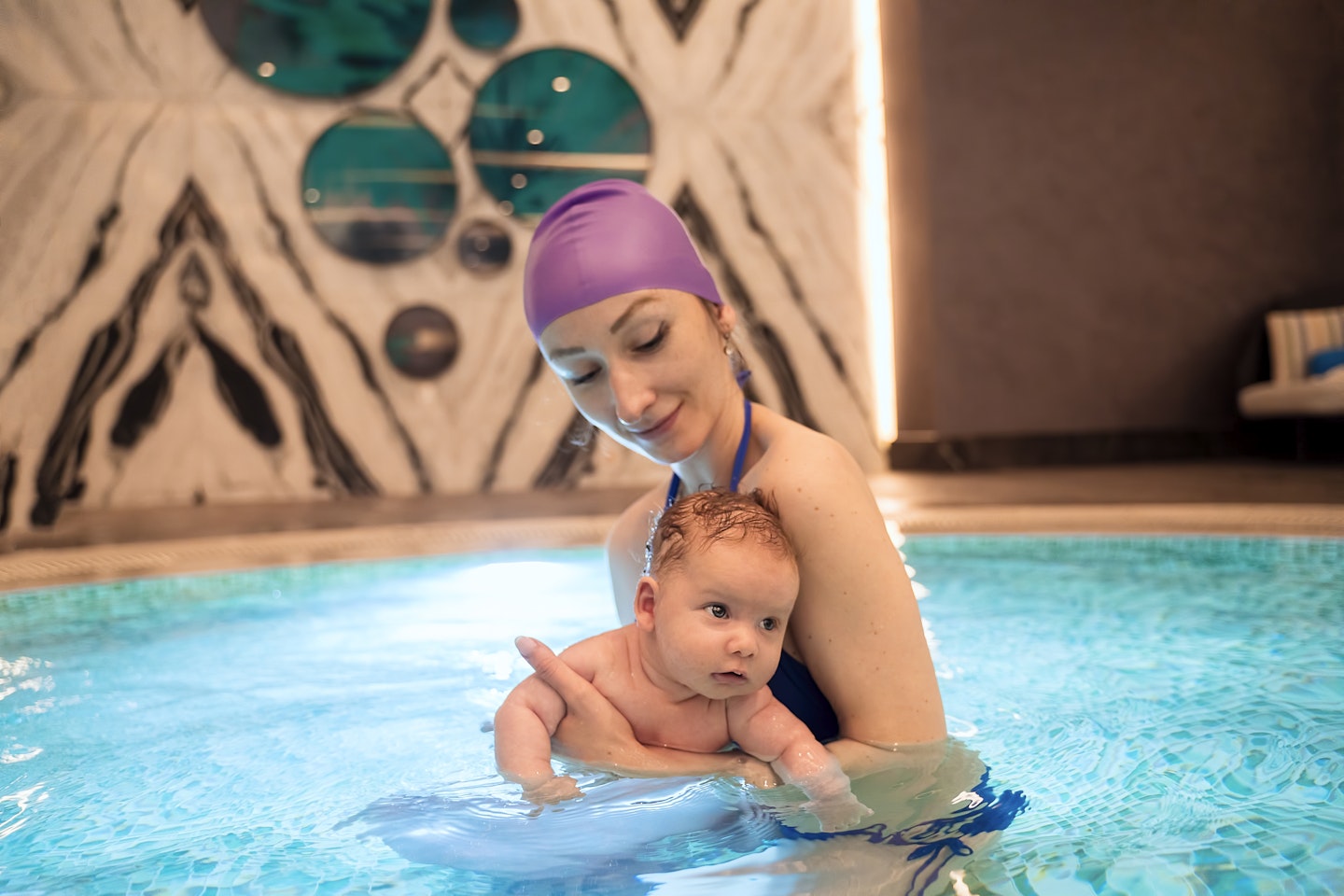
4. If your baby is unsure of the water
If your baby gets distressed once they're in the pool, there’s usually a reason why this happens. Maybe it’s too cold for them or something else is going on like they're hungry or needs a poo. If they cry, hold them close and let them see you, so they feels safe. They're probably getting grumbly because they're ready for a feed, so don’t assume they don't like the pool.
5. Getting out of the pool
Babies soon get tired when they’re in the pool, so don’t keep them in for too long. Ten minutes is about the right amount of time in the water when they're under three months, then build to around 20-30 minutes when they're about six months. It’s best to get out the same way you got in, so hold them close to your chest, with your arms around them and carry them up the steps. Wrap your baby in a towel as soon as they get out, so they don't get cold.
Fun games to play in the water with your baby
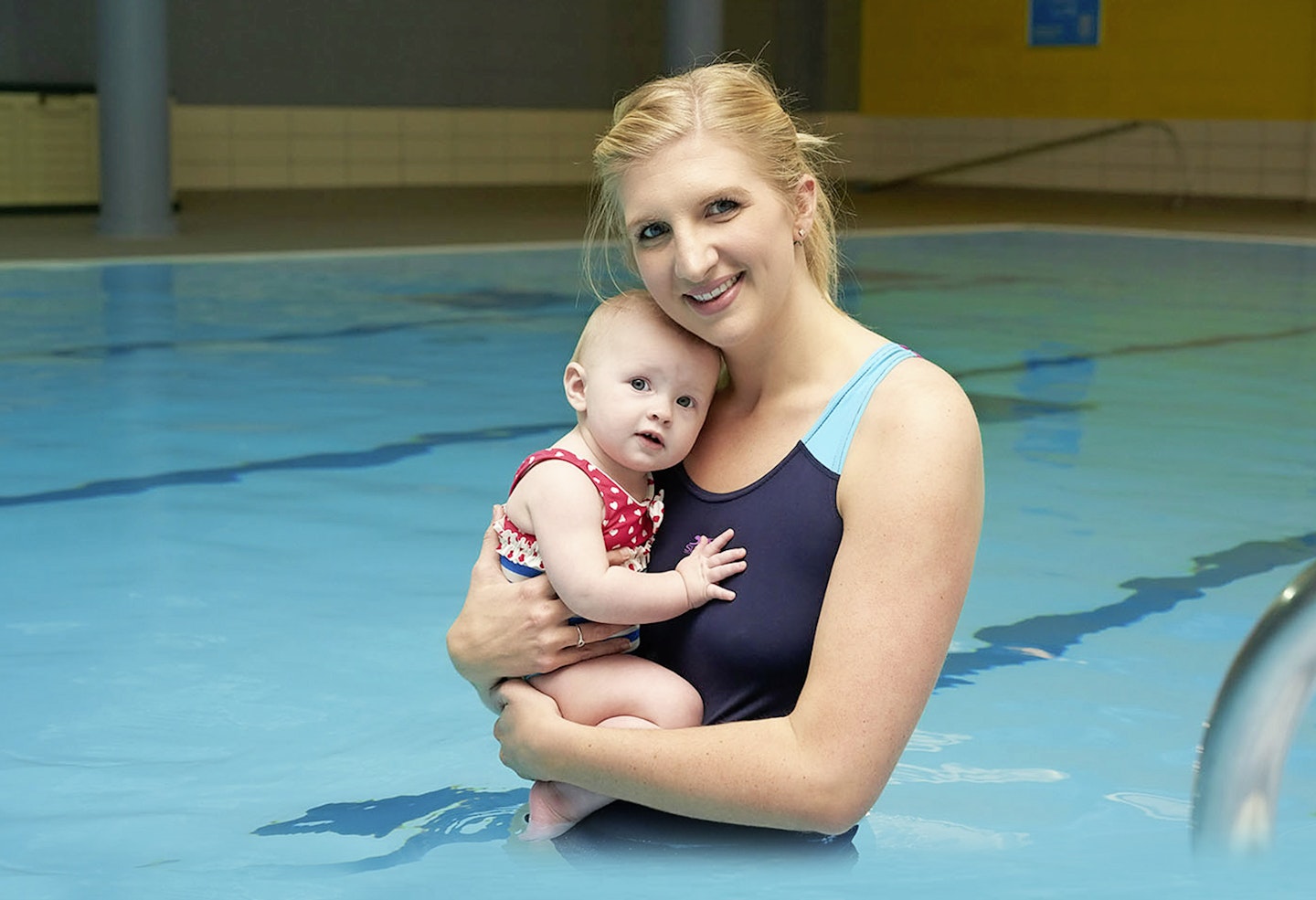
Blowing bubbles
Encouraging your baby to blow bubbles in the water with you is great fun and a good way to help them feel confident putting their face in the water. Becky explains, “The best time to introduce this game is once your baby can hold their head up and is confident floating on their back. Place them gently on their front facing you and hold them under their arms, then blow bubbles in the water and encourage them to copy you.”
Lifting games
Holding your baby under both arms is ideal for playing lifting games, says Becky. “Summer loved it when I lifted her up onto the side of the pool then back down into the water. You could put a towel down on the side of the pool so it’s not too cold. You can also lift your baby up and down in the water as they'll love the motion and it will help them get used to the sensation of being in and out of the water.”
Splashing in the water
“Summer really liked splashing and smacking the water with her hands, which helped her get used to the texture of the water, as well as helping her feel happier getting water splashed on her face.
“I held her around her waist with both hands so she was facing me. This helped us keep eye contact, which was reassuring for her, and also left her with both hands-free to splash about.”
About the expert
Gold medal winning Olympic Swimmer, Rebecca Adlington runs her own swim school for kids aged 3-11. She also has two young children of her own, both of whom she has taught to swim.
